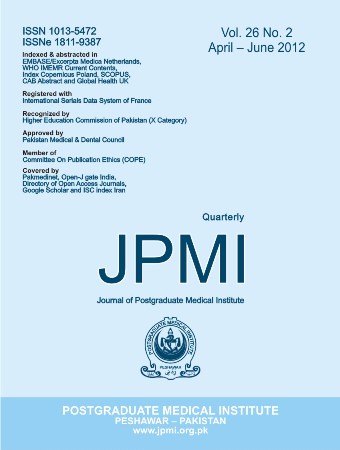SURGICAL TREATMENT OF VESICOVAGINAL FISTULA; AN AUDIT OF 69 CASES
Main Article Content
Abstract
Objective: The aim of this study is to assess the outcome of patients undergoing repair of vesicovaginalfistula.Methodology: This descriptive study which was conducted from May 2002 to March 2008 the Departmentof Urology Lady Reading Hospital Peshawar. A total of 69 patients with Vesicovaginal fistula wereincluded in this study. A detailed history and physical examination with special emphasis on previousgynecological and obstetrical events was recorded. All these patients underwent routine investigations likeHB%, CBC, Urianalysis, renal function test and viral profile with ultrasonography of the abdomen &pelvis. Intravenous Urography(IVU) was offered to those patients who had upper tract dilatation onultrasonography. Preliminary cystoscopy and Vaginoscopy was performed in all patients to diagnose VVFand plan the surgical approach.Result: The mean age was 39.07(+10.031)years. Thirt eight (55%) patients developed fistula due toobstetrical reasons while 30 (43-47%) had gynaecological surgeries and only one patient developed fistulaafter radiotherapy. The average size of the fistula was 3.36 cm: Transabdominal repair of fistula was donein 58(84.1%) patients while 11(15.9%) has transvaginal repair. Successful repair was achieved in65(93.7%) patients.Conclusion: Vesicovaginal fistula can be successfully managed surgically. Proper preoperative assessmentof the patients is mandatory for selection of the surgical approach.
Article Details
How to Cite
1.
Haq A ul, Jan MA, Alam M, Ghani A. SURGICAL TREATMENT OF VESICOVAGINAL FISTULA; AN AUDIT OF 69 CASES. J Postgrad Med Inst [Internet]. 2012 Mar. 23 [cited 2025 Dec. 13];26(2). Available from: https://jpmi.org.pk/index.php/jpmi/article/view/1246
Issue
Section
Original Article
Work published in JPMI is licensed under a
Creative Commons Attribution-NonCommercial 2.0 Generic License.
Authors are permitted and encouraged to post their work online (e.g., in institutional repositories or on their website) prior to and during the submission process, as it can lead to productive exchanges, as well as earlier and greater citation of published work.


